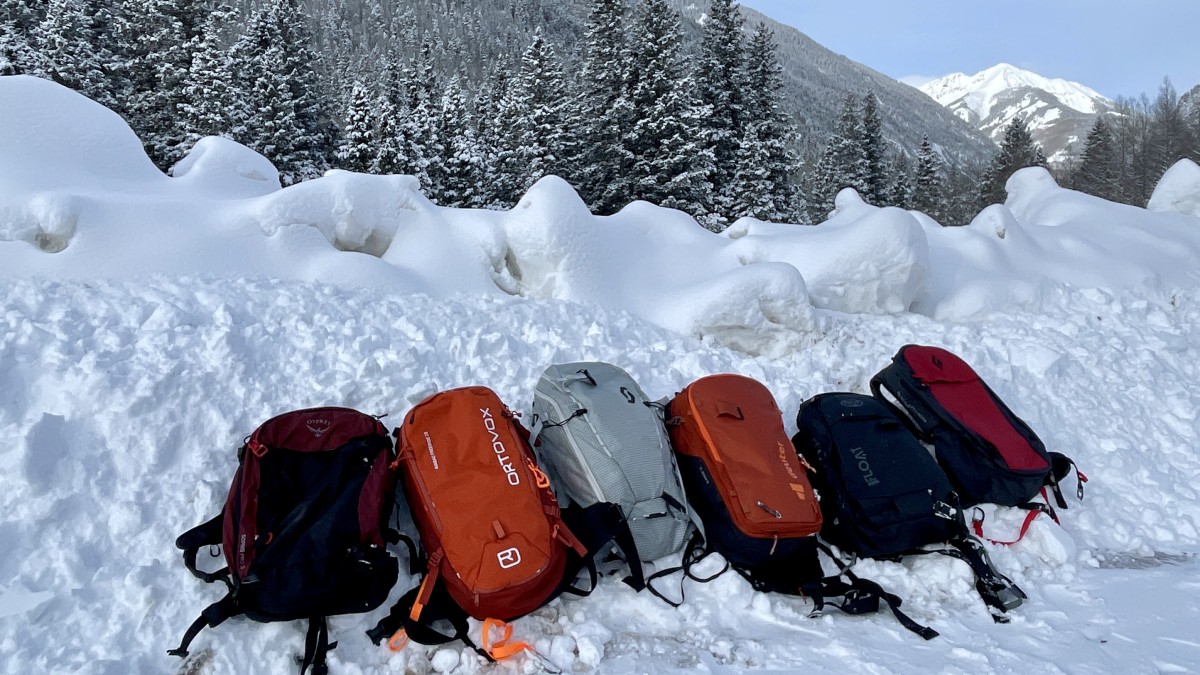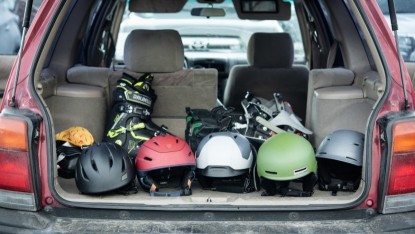Have you ever wondered how exactly an airbag works, the differences between different systems, and how to choose the best one for you? Below, we look at the technologies and key factors to consider when buying this piece of high-tech backcountry equipment. Be sure to check out our review of the the best avalanche airbags, where we compare and contrast the best packs side-by-side.
Essential Avalanche Gear
You have likely heard of the trifecta of avalanche rescue gear – beacon, shovel, probe – but more and more commonly, airbags are also included in safety checks. If you are in a situation where you are using an airbag, you probably also need an avalanche transceiver, so be sure to check out our comprehensive review of the best avalanche beacons.
How Do Avalanche Airbag Packs Work?
Avalanche airbags work through the process of inverse segregation. Inverse segregation – commonly referred to as the 'Brazilian Nut Effect' – is a law of physics where, in a moving mixture, bigger particles work their way to the surface, and smaller particles work their way to the bottom. By wearing and deploying your airbag, it makes you an even bigger "particle" than you would have been otherwise. If you shake a box full of sand and rocks, the rocks will rise to the surface, while the sand will work its way below. The rocks rise to the top because they have more volume than the sand grains. Sometimes, people think that the airbag helps you "float" based on the same principle that would cause a buoyant object to float in water. But the mechanics are different during an avalanche, and the moving snow behaves more like a solid than like a liquid. Thus, particle physics applies – but we digress…
Wearing an Avalanche Airbag Pack
So long as the wearer deploys the airbag, avalanche airbag packs reduce the chances of burial in an avalanche and thus can increase your overall chances of survival. When wearing an avalanche airbag pack, attaching the leg strap is a must for it to function properly. While seemingly inconvenient, it plays a large role in keeping your pack attached to your body if you are caught and carried. Additionally, make sure to have the trigger handle out and ready to use whenever you are traveling in avalanche terrain, and don't hesitate to pull the trigger in the event of an avalanche.
Airbag Technology
Electric Supercapacitors
The technology that was revolutionary several years ago has now become the industry standard for avalanche airbags. Though canister systems may appear cheaper, supercapacitor bags offer a one-time-only cost and are now close to the same weight as their compressed air counterparts. The main difference between these electric airbags and gas-powered ones is that a supercapacitor system offers multiple deployments on a single charge, whereas a canister fully empties with only one deployment. The ability to deploy an airbag multiple times is reassuring during particularly touchy avalanche conditions, and it is especially handy on remote backcountry trips. It also allows you the opportunity to practice using the system – deploying and repacking – without having to refill the canister each time.
The Alpride E2 is the lightest electronic system overall on the market currently, with a 162-liter airbag that charges in less than 30 minutes. It is turned on near the bottom of the pack in a zippered compartment and deflates manually with a portal on the side of the pack. While pushing the deflate button, you must also squeeze out the air, which can be a slight hassle.
The Ortovox LiTRIC features a 150-liter airbag. It also charges quickly, but unlike the Alpride E2 system, which has two backup AA batteries, the LiTRIC system only includes an internal lithium-ion battery. It's turned on via a traditional power button near the top of the pack, which is incredibly convenient compared to other systems whose on/off switches are located at the bottom of the pack. The LiTRIC system also features an innovative trigger mechanism to lock and unlock via a twist-lock handle. It deflates quickly and easily with a deflation tool that inserts like a key to the supercapacitor unit.
The Black Diamond Jetforce system features the largest airbag of the three systems currently on the market at 200 liters. It is also reinforced with Cordura fabric to prevent potential rips in the bag. We also think that it's the easiest to turn on – via a button right on the trigger handle, without having to take off the pack – and the easiest to repack. It self-deflates after 5 minutes, which could also help provide a better air pocket, in the event you're fully buried in an avalanche. Unfortunately, this system is the heaviest, but also perhaps the easiest to use.
Compressed Air
Backcountry Access, Arva, and Mammut, among others, use compressed air systems to inflate their airbags – with the advent of supercapacitor technology, we now commonly refer to these as 'canister packs'. These models use a compressed air canister filled to around 2700-3000 PSI with a venturi value to inflate a 150-liter bag.
They aren't as easy as plugging into your wall, but if you're travelling through more urban areas, these canisters are quite easy to refill. This is because the universal fitting to fill all compressed air canisters is used for most scuba, paintball, glass blowing, and other activities. That means you can take your compressed air canister to most scuba or paintball shops, and they can refill it for you, even if they haven't ever heard of an airbag pack before.
The primary disadvantage of compressed air is that you only get a single detonation of your airbag per canister. While air travel is a little bit more of a hassle – especially if you're only wearing your airbag once a year on a ski trip to somewhere like Alaska – we would discourage this as a deciding factor. The reality is it isn't that hard to find a place to refill a canister, but it is hard to argue with the convenience factor of a battery-powered model.
Considerations When Looking at Airbag Packs
How Are You Going to Use Your Avalanche Airbag Pack?
What kind of backcountry skiing and snowboarding will you be doing? Will you be primarily helicopter skiing (lucky you), snowcat skiing, lift-accessed backcountry skiing, human-powered touring, ski mountaineering, hut-to-hut trips, or, most likely, a combination of these? Understanding how and where you'll be wearing your new airbag pack will help highlight certain features that might be more important than others.
Heli and Cat Skiing and Snowboarding
As helicopter and cat skiers and snowboarders, you won't need to carry much, and having a smaller pack that fits better on the downhill is more advantageous than one with more volume or pockets. The ski/snowboarding carrying system doesn't have to be very adjustable (or sometimes, even exist at all) because the odds of you having to strap your skis or board to your pack are slim. Most cat and heli skiers either choose airbag vests or small packs, generally between 15 and 25 liters. Heli and cat skiers should strongly consider a battery-powered fan pack versus compressed air as they frequently travel to their destinations. This will save time and hassle at the airport and any inconvenience around refilling a compressed air cartridge. Consider a pack with more durability as well since it may be frequently tossed in metal baskets.
Lift-accessed Backcountry
Lift-accessed backcountry or "sidecountry" generally refers to skiers and snowboarders who access the backcountry via a ski resort gate. This type of access can include a fair amount of bootpacking and potentially skinning. Many lift-accessed backcountry skiers look for packs with a volume of 15 to 30 liters. For this application, you'll want a pack big enough to be able to carry all of your equipment and a few extra layers. Ideally, a pack will also have a good ski or snowboard carry system. Keep in mind that sidecountry terrain is still the backcountry. Without any guaranteed response from ski patrol, you want to be prepared for any emergency that might happen, so make sure to have a pack that is large enough to carry your rescue essentials.
Backcountry Touring
Backcountry touring refers to skiers and snowboarders generally accessing the backcountry by skinning. As tours often last all day (or longer), most backcountry tourers look for packs between 25 and 45 liters. Having a solid ski or splitboard carrying system is key because, unlike a lot of sidecountry boot packing, the ascents are often longer, and carrying skis over your shoulder is often impractical and painful. If you like the design of a compressed air model, we'd recommend buying it because, most of the time, we will go on backcountry tours in our home ranges. Even if you travel for a ski touring trip, finding a spot to refill a compressed air canister often isn't too much of a hassle.
Hut-to-Hut or Multi-Day Ski Touring
For hut-to-hut and multi-day trips, most of the features you want are similar to those of a backcountry touring pack, with a few additional requirements. To start, you will likely want a slightly larger volume pack. For a self-supported trip like the Spearhead Traverse, you will likely need a pack of at least 40 liters in volume; for hut-to-hut trips like the Haute Route, you may be able to get away with packs as small as 30 liters. Weight distribution and the weight of the pack itself also become an issue because you likely have to carry more. We also tend to like a few more compartments and pockets as well, because they come in handy for gear organization. Space-to-weight ratio – meaning how large the pack is and how much it weighs – comes into play heavily when looking for an avalanche airbag pack for multi-day trips.






















